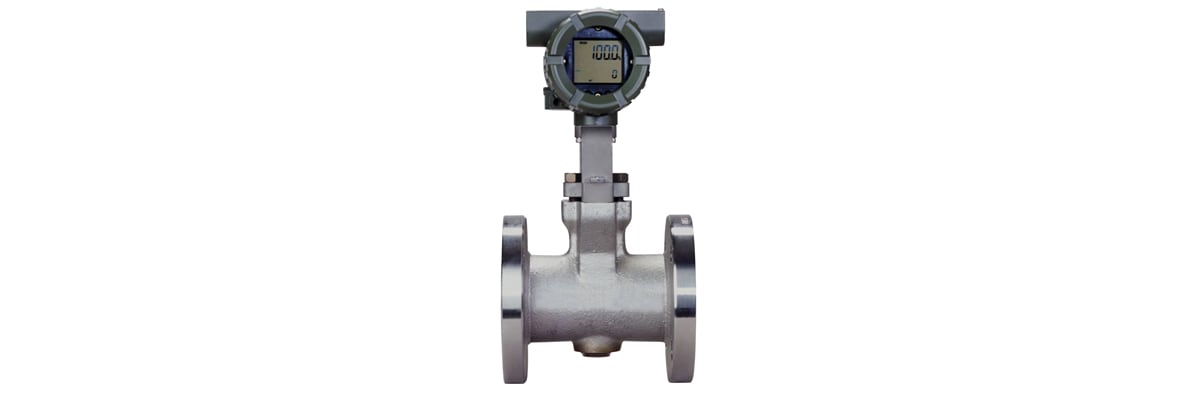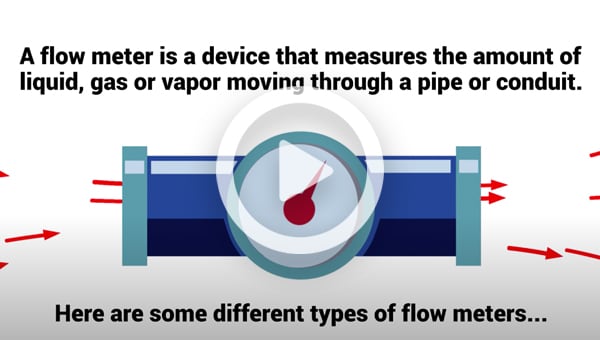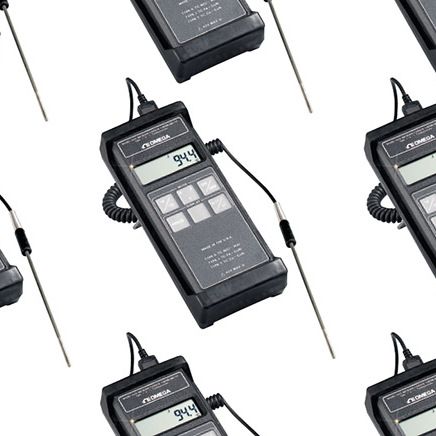What is a Flow Meter?
A flow meter (or a flow sensor) is an flow instrument that is used to indicate the amount of liquid, gas, or vapor moving through a pipe or conduit by measuring linear, non-linear, mass, or volumetric flow rates. Since flow control is often essential, measuring the flow of liquids and gasses is a critical need for many industrial applications – and there are many different types of flow meters that can be utilized depending on the nature of the application.
When choosing a flow meter to buy, one should consider such intangible factors as familiarity of plant personnel, their experience with c and maintenance, spare parts availability, and meant time between failure history, etc., at the particular plant site. It is also recommended that the cost of the installation be computed only after taking these steps. One of the most common flow measurement mistakes is the reversal of this sequence: instead of selecting a sensor which will perform properly, an attempt is made to justify the use of a device because it is less expensive. Those “inexpensive” purchases can be the costliest installations.
Flow Meter Types and Uses
Differential Pressure Flow Meters
The use of differential pressure as an inferred measurement of a liquid’s rate of flow is well known. Differential pressure flow meters are, by far, the most common units in use today. These meters, which boast high accuracy, calculate fluid flow by reading pressure loss across a pipe restriction. Estimates are that over 50 percent of all liquid flow measurement applications use this type of unit.
The basic operating principle of differential pressure flow meters is based on the premise that the pressure drop across the meter is proportional to the square of the flow rate. The flow rate is obtained by measuring the pressure differential and extracting the square root.
Differential pressure flow meters, like most flow meters, have a primary and secondary element. The primary element causes a change in kinetic energy, which creates the differential pressure in the pipe. The unit must be properly matched to the pipe size, flow conditions, and the liquid’s properties. And, the measurement accuracy of the element must be good over a reasonable range. The secondary element measures the differential pressure and provides the signal or read-out that is converted to the actual flow value.
Orifice Flow Meters
Orifice flow meters are the most popular liquid flow meters in use today. An orifice is simply a flat piece of metal with a specific-sized hole bored in it. Most orifices in use are of the concentric type, but eccentric, conical (quadrant), and segmental designs are also available.
In practice, the orifice plat is installed in the pipe between two flanges. Acting as the primary device, the orifice constricts the flow of liquid to produce a differential pressure across the plate. Pressure taps on either side of the plate are used to detect the difference. Major advantages of orifices are that they have no moving parts, and their cost does not increase significantly with pipe size.
Conical and quadrant orifices are relatively new. The units were developed primarily to measure liquids with low Reynolds numbers. Essentially constant flow coefficients can be maintained at R values below 5000. Conical orifice plates have an upstream bevel, the depth and angle of which must be calculated and machined for each application.
The segmental wedge is a variation of the segmental orifice. It is a restriction orifice primarily designed to measure the flow of liquids containing solids. The unit has the ability to measure flows at low Reynolds numbers and still maintain the desired square-root relationship. Its design is simple, and there is only one critical dimension the wedge gap. Pressure drop through the unit is only about half that of conventional orifices.
Integral wedge assemblies combine the wedge element and pressure taps into a one-piece pipe coupling bolted to a conventional pressure transmitter. No special piping or fittings are needed to install the device in a pipeline.
Metering accuracy of all orifice flowmeters depends on the installation conditions, the orifice area ratio, and the physical properties of the liquid being measured.
Venturi Flow Meters
Venturi tubes have the advantage of being able to handle large flow volumes at low pressure drops. A venturi tube is essentially a section of pipe with a tapered entrance and a straight throat. As liquid passes through the throat, its velocity increases, causing a pressure differential between the inlet and outlet regions.
The flowmeters have no moving parts. They can be installed in large diameter pipes using flanged, welded or threaded-end fittings. Four or more pressure taps are usually installed with the unit to average the measured pressure. Venturi tubes can be used with most liquids, including those having a high solids content.
Pitot Tube Flow Meter
Pitot tubes are generally installed by welding a coupling on a pipe and inserting the probe through the coupling. Use of most pitot tubes is limited to single point measurements. The units are susceptible to plugging by foreign material in the liquid. Advantages of pitot tubes are low cost, absence of moving parts, easy installation, and minimum pressure drop.
Positive Displacement Flow Meters
Operation of these units consists of separating liquids into accurately measured increments and moving them on. Each segment is counted by a connecting register. Because every increment represents a discrete volume, positive-displacement units are popular for automatic batching and accounting applications. Positive-displacement meters are good candidates for measuring the flows of viscous liquids or for use where a simple mechanical meter system is needed.
Reciprocating piston meters are of the single and multiple-piston types. The specific choice depends on the range of flow rates required in the particular application. Piston meters can be used to handle a wide variety of liquids. A magnetically driven, oscillating piston meter is shown in Fig. 1. Liquid never comes in contact with gears or other parts that might clog or corrode.
 Figure 1: Oscillating-piston meter operates on magnetic drive principle so that liquid will not come in contact with parts. A partition plate between inlet and outlet ports forces incoming liquid to flow around a cylindrical measuring chamber and through the outlet port. The motion of the oscillating piston in the unit is transferred to a magnetic assembly in the measuring chamber, which is coupled to a follower magnet on the other side of the chamber wall.
Figure 1: Oscillating-piston meter operates on magnetic drive principle so that liquid will not come in contact with parts. A partition plate between inlet and outlet ports forces incoming liquid to flow around a cylindrical measuring chamber and through the outlet port. The motion of the oscillating piston in the unit is transferred to a magnetic assembly in the measuring chamber, which is coupled to a follower magnet on the other side of the chamber wall.
Oval-gear meters have two rotating, oval-shaped gears with synchronized, close fitting teeth. A fixed quantity of liquid passes through the meter for each revolution. Shaft rotation can be monitored to obtain specific flow rates.
Nutating-disk meters have a moveable disk mounted on a concentric sphere located in a spherical side-walled chamber. The pressure of the liquid passing through the measuring chamber causes the disk to rock in a circulating path without rotating about its own axis. It is the only moving part in the measuring chamber.
A pin extending perpendicularly from the disk is connected to a mechanical counter that monitors the disk's rocking motions. Each cycle is proportional to a specific quantity of flow. As is true with all positive-displacement meters, viscosity variations below a given threshold will affect measuring accuracies. Many sizes and capacities are available. The units can be made from a wide selection of construction materials.
Rotary-vane meters are available in several designs, but they all operate on the same principle. The basic unit consists of an equally divided, rotating impeller (containing two or more compartments) mounted inside the meter's housing. The impeller is in continuous contact with the casing. A fixed volume of liquid is swept to the meter's outlet from each compartment as the impeller rotates. The revolutions of the impeller are counted and registered in volumetric units.
Helix flow meters consist of two radically pitched helical rotors geared together, with a small clearance between the rotors and the casing. The two rotors displace liquid axially from one end of the chamber to the other.
Volumetric Flow Meters
These instruments operate linearly with respect to the volume flow rate. Because there is no square-root relationship (as with differential pressure devices), their rangeability is greater. Volumetric meters have minimum sensitivity to viscosity changes when used at Reynolds numbers above 10,000. Most velocity-type meter housings are equipped with flanges or fittings to permit them to be connected directly into pipelines.
Turbine Flow Meters
Turbine meters have found widespread use for accurate liquid measurement applications. The unit consists of a multiple-bladed rotor mounted with a pipe, perpendicular to the liquid flow. The rotor spins as the liquid passes through the blades. The rotational speed is a direct function of flow rate and can be sensed by magnetic pick-up, photoelectric cell, or gears. Electrical pulses can be counted and totalized, Fig. 2.
 Figure 2: Turbine flow meter consists of a multiple-bladed, free-spinning, permeable metal rotor housed in a non-magnetic stainless-steel body. In operation, the rotating blades generate a frequency signal proportional to the liquid flow rate, which is sensed by the magnetic pickup and transferred to a read-out indicator.
Figure 2: Turbine flow meter consists of a multiple-bladed, free-spinning, permeable metal rotor housed in a non-magnetic stainless-steel body. In operation, the rotating blades generate a frequency signal proportional to the liquid flow rate, which is sensed by the magnetic pickup and transferred to a read-out indicator.
The number of electrical pulses counted for a given period of time is directly proportional to flow volume. A tachometer can be added to measure the turbine's rotational speed and to determine the liquid flow rate. Turbine meters, when properly specified and installed, have good accuracy, particularly with low-viscosity liquids.
A major concern with turbine meters is bearing wear. A "bearingless" design has been developed to avoid this problem. Liquid entering the meter travels through the spiraling vanes of a stator that imparts rotation to the liquid stream. The stream acts on a sphere, causing it to orbit in the space between the first stator and a similarly spiraled second stator. The orbiting movement of the sphere is detected electronically. The frequency of the resulting pulse output is proportional to flow rate.
Vortex Flow Meters
Vortex meters make use of a natural phenomenon that occurs when a liquid flows around a bluff object. Eddies or vortices are shed alternately downstream of the object. The frequency of the vortex shedding is directly proportional to the velocity of the liquid flowing through the meter, Fig. 3.
 Figure 3: Vortex meters operate on the principle that when a non-streamlined object is placed in the middle of a flow stream, a series of vortices are shed alternately downstream of the object. The frequency of the vortex shedding is directly proportional to the velocity of the liquid flowing in the pipeline.
Figure 3: Vortex meters operate on the principle that when a non-streamlined object is placed in the middle of a flow stream, a series of vortices are shed alternately downstream of the object. The frequency of the vortex shedding is directly proportional to the velocity of the liquid flowing in the pipeline.
The three major components of the flowmeter are a bluff body strut-mounted across the flowmeter bore, a sensor to detect the presence of the vortex and to generate an electrical impulse, and a signal amplification and conditioning transmitter whose output is proportional to the flow rate, Fig. 4. The meter is equally suitable for flow rate or flow totalization measurements. Use for slurries or high viscosity liquids is not recommended.
 Figure 4
Figure 4
Magmeter
Electromagnetic meters can handle most liquids and slurries, providing that the material being metered is electrically conductive. The flow tube mounts directly in the pipe. Pressure drop across the meter is the same as it is through an equivalent length of pipe because there are no moving parts or obstructions to the flow. The voltmeter can be attached directly to the flow tube or can be mounted remotely and connected to it by a shielded cable.
Electromagnetic flow meters operate on Faraday's law of electromagnetic induction that states that a voltage will be induced when a conductor moves through a magnetic field. The liquid serves as the conductor; the magnetic field is created by energized coils outside the flow tube, Fig. 5. The amount of voltage produced is directly proportional to the flow rate. Two electrodes mounted in the pipe wall detect the voltage, which is measured by the secondary element.
 Figure 5: Major components of obstruction-free electromagnetic flow meter’s flow tube include electrodes and coils.
Figure 5: Major components of obstruction-free electromagnetic flow meter’s flow tube include electrodes and coils.
Electromagnetic flow meters have major advantages: They can measure difficult and corrosive liquids and slurries; and they can measure forward as well as reverse flow with equal accuracy. Disadvantages of earlier designs were high power consumption, and the need to obtain a full pipe and no flow to initially set the meter to zero. Recent improvements have eliminated these problems. Pulse-type excitation techniques have reduced power consumption, because excitation occurs only half the time in the unit. Zero settings are no longer required.
Ultrasonic Flow Meters
Ultrasonic flow meters can be divided into Doppler meters and Time-of-Travel (or Transit) meters. Doppler meters measure the frequency shifts caused by liquid flow. Two transducers are mounted in a case attached to one side of the pipe. A signal of known frequency is sent into the liquid to be measured. Solids, bubbles, or any discontinuity in the liquid, cause the pulse to be reflected to the receiver element, Fig. 6. Because the liquid causing the reflection is moving, the frequency of the returned pulse is shifted. The frequency shift is proportional to the liquid's velocity.
 Figure 6
Figure 6
A portable Doppler meter capable of being operated on AC power or from a rechargeable power pack has recently been developed. The sensing heads are simply clamped to the outside of the pipe, and the instrument is ready to be used. Total weight, including the case, is 22 lb. A set of 4 to 20 millampere output terminals permits the unit to be connected to a strip chart recorder or other remote device.
Time-of-travel meters have transducers mounted on each side of the pipe. The configuration is such that the sound waves traveling between the devices are at a 45 deg. angle to the direction of liquid flow. The speed of the signal traveling between the transducers increases or decreases with the direction of transmission and the velocity of the liquid being measured. A time-differential relationship proportional to the flow can be obtained by transmitting the signal alternately in both directions. A limitation of time-of-travel meters is that the liquids being measured must be relatively free of entrained gas or solids to minimize signal scattering and absorption.
Mass Flow Meters
The continuing need for more accurate flow measurements in mass-related processes (chemical reactions, heat transfer, etc.) has resulted in the development of mass flowmeters. Various designs are available, but the one most commonly used for liquid flow applications is the Coriolis mass flow meter. Its operation is based on the natural phenomenon called the Coriolis force, hence the name.
Coriolis flow meters are true mass meters that measure the mass rate of flow directly as opposed to volumetric flow. Because mass does not change, the meter is linear without having to be adjusted for variations in liquid properties. It also eliminates the need to compensate for changing temperature and pressure conditions. The meter is especially useful for measuring liquids whose viscosity varies with velocity at given temperatures and pressures.
Coriolis flow meters are true mass meters that measure the mass rate of flow directly as opposed to volumetric flow. Because mass does not change, the meter is linear without having to be adjusted for variations in liquid properties. It also eliminates the need to compensate for changing temperature and pressure conditions. The meter is especially useful for measuring liquids whose viscosity varies with velocity at given temperatures and pressures.
Coriolis meters are also available in various designs. A popular unit consists of a U-shaped flow tube enclosed in a sensor housing connected to an electronics unit. The sensing unit can be installed directly into any process. The electronics unit can be located up to 500 feet from the sensor.
Inside the sensor housing, the U-shaped flow tube is vibrated at its natural frequency by a magnetic device located at the bend of the tube. The vibration is similar to that of a tuning fork, covering less than 0.1 in. and completing a full cycle about 80 times/sec. As the liquid flows through the tube, it is forced to take on the vertical movement of the tube, Fig. 7. When the tube is moving upward during half of its cycle, the liquid flowing into the meter resists being forced up by pushing down on the tube.
 Figure 7
Figure 7
Having been forced upward, the liquid flowing out of the meter resists having its vertical motion decreased by pushing up on the tube. This action causes the tube to twist. When the tube is moving downward during the second half of its vibration cycle, it twists in the opposite direction.
Having been forced upward, the liquid flowing out of the meter resists having its vertical motion decreased by pushing up on the tube. This action causes the tube to twist. When the tube is moving downward during the second half of its vibration cycle, it twists in the opposite direction. The ammount of twist is directly proportional to the mass flow rate of the liquid flowing through the tube. Magnetic sensors located on each side of the flow tube measure the tube velocities, which change as the tube twists. The sensors feed this information to the electronics unit, where it is processed and converted to a voltage proportional to mass flow rate. The meter has a wide range of applications from adhesives and coatings to liquid nitrogen.
Thermal-type mass flowmeters have traditionally been used for gas measurements, but designs for liquid flow measurements are available. These mass meters also operate independent of density, pressure, and viscosity. Thermal meters use a heated sensing element isolated from the fluid flow path. The flow stream conducts heat from the sensing element. The conducted heat is directly proportional to the mass flow rate. The sensor never comes into direct contact with the liquid. The electronics package includes the flow analyzer, temperature compensator, and a signal conditioner that provides a linear output directly proportional to mass flow.



